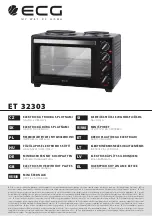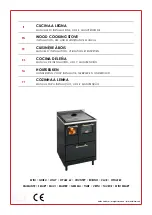
Page 9
6. Safety Notes
Fires are dangerous
– Use a fireguard in the presence of children, the elderly or the infirm.
Warning – fume emission
Properly installed and operated, this appliance will not emit fumes. Occasional fumes from de-
ashing and refuelling may occur which is not normally of serious concern.
However, persistent
fume emission is potentially dangerous and must not be tolerated.
If fume emission does persist, then the following immediate action should be taken: -
1
.
Open doors and windows to ventilate room
2
.
Let the fire go out, or remove and safely dispose of fuel from the appliance.
3
.
Check for flue chimney blockage and clean if required.
4
.
Do not attempt to re-light the fire until the cause has been identified and corrected.
If necessary, seek professional advice from Chimney or Stove specialists.
Important! –
Do not fit an extractor fan in the same room as this appliance; it
WILL
interfere with
combustion air provision and can cause products of combustion to be drawn into the room.
In the event of a chimney fire
5
.
Raise the alarm to let others in the house know.
6
.
Call the Fire Brigade
7
.
Reduce the appliance-burning rate by closing all air controls fully.
8
.
Move furniture and rugs away from the fireplace and remove any nearby ornaments.
9
.
Place a fireguard or spark guard in front of the Stove.
10
. Feel the chimney breast for sign of excessive heat.
If the wall is becoming hot, move the furniture away. Ensure that the Fire Brigade can gain access
to your roof space in order to check this area for signs of fire spread.
If it is thought that a chimney fire has occurred and the symptoms are not always obvious, it is
important that the chimney and flue structure is examined by a competent person to ensure that
the integrity of the flues within the chimney or any flue liners have not been compromised.
Severe damage can seriously impede the safe evacuation of combustion gases from the
appliance. An important clue to the likely presence of a chimney fire could well be a loud
resonating and pulsing noise emanating from the direction of the appliance.
Do not excessively load the firebox.
– it is possible to over fire the Stove beyond its design
capacity, this could damage the Stove, so watch for signs of over firing – if any part of the Stove
starts to glow red, the fire is in an over fire situation and the controls should be adjusted
accordingly. Never leave the Stove unattended for long periods without first adjusting the controls
to a reduced and safe setting – careful air supply control should be exercised at all times.
The external surface temperature should never be
o
allowed to exceed 300 C. For optimum performance
the external surfaces of the stove would normally be
o
o
in the region of 200 C - 250 C. To assist in determining
external surface temperatures, we recommend the
use of the SmartTemp which is an infrared digital
remote sensing thermometer which provides a very
accurate temperature reading. It is operated by
simply pointing the “gun” at the stove surface and
pulling the trigger. The temperature is then displayed
on an LCD screen.
S
MART
P
T
E
M
































